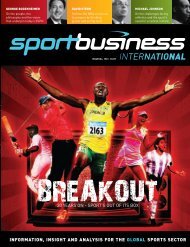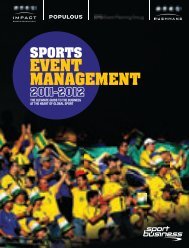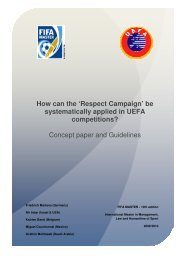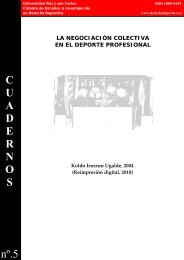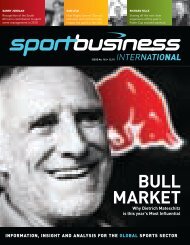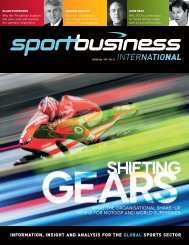01 cover sbi 152.indd - FIFA/CIES International University Network
01 cover sbi 152.indd - FIFA/CIES International University Network
01 cover sbi 152.indd - FIFA/CIES International University Network
Create successful ePaper yourself
Turn your PDF publications into a flip-book with our unique Google optimized e-Paper software.
RIGHTS FOCUS:<br />
JUMP RACING<br />
JUMPING FOR<br />
SUCCESS<br />
The National Hunt horse racing season is in full swing, attracting large<br />
crowds and betting revenues. As Adrian Hill explains, British Jump racing<br />
is in rude health.<br />
BY ANY REASONABLE MEASURE the British<br />
Racing industry is at the forefront of the UK<br />
sporting and leisure markets, and the Jump<br />
racing sector plays a major part in that success<br />
story. The quality and breadth of the National<br />
Hunt scene in the British Isles is unrivalled<br />
anywhere else in the world.<br />
The Grand National and the Cheltenham<br />
Festival are renowned as two of the UK’s<br />
top sporting events, attracting extensive TV<br />
<strong>cover</strong>age. While 5.7 million spectators attended<br />
the 60 tracks operating in Britain in 2008, a<br />
figure second only to football among UK sports.<br />
Bearing in mind that the highlights of the<br />
National Hunt season occur during the winter<br />
and early spring months, a tally of two million<br />
people going through the gates to see steeple<br />
chasing is some achievement.<br />
According to the British Horseracing<br />
Authority’s Economic Impact report, UK<br />
racecourses produced revenue of £456 million<br />
in 2008 - a sum bettered only by football and<br />
£90 million more than the third-placed sport,<br />
rugby union.<br />
“I think British racing is in a pretty healthy<br />
state,” says Alan Switzer, director of the Sport<br />
Business group at Deloitte which produced the<br />
study. “Our report relies mostly on data from<br />
2008. Due to the recession, in some instances<br />
the figures might show peaks for some time. But<br />
attendances, the number of racehorse owners<br />
and media <strong>cover</strong>age are all in a healthy state.<br />
Crowds in 2009, up until the end of September,<br />
were marginally up too.”<br />
The report also reveals that the UK<br />
government was handed £325 million in tax<br />
income from British racing and its role as a<br />
very significant employer. Only a handful of<br />
British rugby stadia could accommodate the<br />
18,600 working full-time within the core racing<br />
industry, while if those who earn a living from<br />
related fields, such as betting, are included<br />
even Twickenham would not be big enough. An<br />
estimated 100,000 people directly or indirectly<br />
look to racing for their livelihoods. Success<br />
comes from investment and £706 million<br />
worth of capital resources were spent on the<br />
racecourses from 2004 to 2008. This added<br />
to the annual £400 million that the 50,000<br />
racehorse owners contribute, a significant<br />
proportion of which is inbound from major<br />
overseas benefactors.<br />
The effect of the recession has made the<br />
loyal band of owners dwindle slightly. Racing<br />
is an expensive sport, although unlike its Flat<br />
counterpart, Jump racing at the highest level,<br />
is not the sole playground of the extravagantly<br />
wealthy. Switzer reports that owners are feeling<br />
the pinch.<br />
“The number of owners has gone down this<br />
year, but has by no means fallen off the cliff.<br />
Where we have seen a marked decline is in<br />
bloodstock, the buying and selling of horses.<br />
However, the big yearling sales in October held up<br />
reasonably well, thanks to the support of wealthy<br />
benefactors such as the Maktoum family.”<br />
Affluent patriarchs<br />
The seriously affluent racing patriarchs tend to<br />
concentrate on the Flat, where the long-term<br />
bounty available from the breeding of champion<br />
racehorses dwarfs prize money. A top-class<br />
stallion earns a five-figure stud fee, with recently<br />
retired Derby and Prix de l’Arc de Triomphe<br />
hero Sea The Stars expected to attract nearly<br />
£100,000 every time he is matched with a mare.<br />
The practice of gelding top-class National<br />
Hunt performers means that avenue is not<br />
open to its owners and a major attraction<br />
of the winter sport is the continuity<br />
provided by its top horses returning<br />
season after season. Followers identify<br />
with them and there is a clear structure<br />
to the campaign, with Cheltenham and<br />
Aintree providing a rousing climax.<br />
Take the two superstars of the respective<br />
racing codes in Europe this year. Sea The Stars<br />
has been packed off to stud after a career of only<br />
two years while Cheltenham Gold Cup winner<br />
Kauto Star aims to retain his crown next March<br />
to round off a sixth campaign in the UK, having<br />
previously raced in France.<br />
“It’s a fantastic storyline for broadcasters<br />
and the public at large,” says Peter McNeile,<br />
Cheltenham’s sponsorship director. “If Channel<br />
4 were to ever lose the Festival, their interest<br />
in racing would probably wane. If a horse wins<br />
a race in December there is always talk about<br />
which race at the festival it is being aimed at - it<br />
engages the occasional viewer.”<br />
Cheltenham - Getty Images Sport<br />
62 SportBusiness <strong>International</strong> • No. 152 • 12.09




